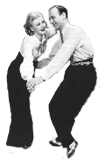 |
ROUND DANCING — CHOREOGRAPHED BALLROOMEDUCATIONAL ARTICLESMAJOR SECTIONS: Figures | Articles | Links | Alph. Index | Search | Home |
|
|
Smile — Dancing Is About the Relationshipby Harold & Meredith Sears When we first learn a new figure, a new amalgamation, a new dance, it is natural to focus on the steps and the figures? But if we want to feel good and look good, we need to go beyond technical accuracy and incorporate into our dancing a relationship with our partner. Without a relationship, the dance is just steps, just exercise, just earnest, unsmiling locomotion. But if the dance contains emotion and communication, then we have something more than exercise. We have art. Of course, we need to execute the steps, but the steps only make up the foundation of a dance. Built on top of the steps, we need to feel the fun, the story that the dance might be telling, or the picture that it’s painting. If we can show that we enjoy our partner, if we can play off our partner and respond emotionally to the music and to the movements of the dance, then we can achieve a richness that goes well beyond the dance routine. Fred and Ginger —Fred Astaire and Ginger Rogers made ten movies in all, nine between 1933 and 1939 and then a tenth, in 1949, almost by accident (Judy Garland was originally cast for the part). Of course, Fred and Ginger dance beautifully, but the beauty emerges especially because those dances are more than their steps. Many are wonderfully fun. Some are serious and dramatic, and some are even tragic. Their dances are physically and emotionally rich. Each dance embodies a human relationship. One of the lightest Fred-and-Ginger dances, from Follow the Fleet, 1936, is "I’m Putting All My Eggs In One Basket," a goofy, clowning, clumsy, and silly dance. But they are having fun, and they show it. They smile at the pleasure of their own movements. They make eye contact. They laugh. They aren’t just working through a sequence. They aren’t working at all. They aren’t mechanical in their movements. They are relating to each other with body language, facial expression, and gesture. They’re doing it to the music, but there is life, relationship, and emotion in every move.
"Night and Day," from Gay Divorcee, 1934, is a little more serious — it is three full minutes of dramatic seduction, and Ginger certainly succumbs. At the start, he approaches, and she dodges and shies. He follows and cuts her off. He takes her hand and she turns to him. He dances a flourish, and she is intrigued. He draws her to him. They look deep into each other’s eyes, she reluctant, he intense. She submits, intensity increasing, cheek to cheek, greater abandon, rapid pivots. Finally, slowing, together, pivot 1, 2, 3, and he gently lowers her to an upholstered bench. She is motionless, smitten, eyes wide in wordless awe. Gazing up, aglow, she has been courted and won. They smile, perhaps a bit shyly. He offers her a cigarette. "Never Gonna Dance," from Swing Time, is a dance of parting. They cannot be together. He cannot dance with her, so he feels that he will never dance again. Their expressions are tragic, eyes cast down, movements slow. There is wistful yearning. They sway like grasses in a soft breeze. She turns and walks away, head down. The tempo picks up a little and he snatches her arm and turns her. They gaze at each other intently. There is a rock-4 with great pleading, and then explosive but bittersweet exuberance, and they part. Fred danced with many, many partners in a dancing career that spanned more than 60 years, but no one was better than Ginger. She wasn’t the most highly trained, technically proficient, agile, or athletic, but she was the most human, charming, and responsive. She showed that she loved dancing with Fred. In the thirties, they were top box office draws, and then and long after, thousands, maybe millions, wanted to dance like them. Why? Not because they were skilled, though they certainly were. Not because the dances were complex and the steps tricky, though they were. Not even because the music was beautiful, though it certainly was. We love their dancing because they love their dancing and the passion shows. Women would dream of dancing with Fred because Ginger made it clear that there was no experience that was better. Men would dream of dancing like Fred because they wanted women to feel about them as Ginger obviously felt about Fred.Other Astaire partners were more highly trained, but maybe for that reason, their dances were more about the steps. Ginger’s dancing was about the relationship. The familiar joke is that Ginger did everything that Fred did but backwards and in high heels. She did that, but her greater contribution to their dancing was her response to Fred. They responded to each other, and those relationships make their dances thrilling. We can do it too. We can work to get the steps right, but we can also think about developing emotional responses that are complementary to the music and to the dance. We can think about communicating those emotions through posture and expression. We can create a relationship with our partner. We can at least smile.
A version of this article was published in American Dancer, 13:16-17, 7,8/2008 and reprinted in the Dixie Round Dance Council Newsletter, February 2009 . "Pick Yourself Up" photo from Fred Astaire by Roy Pickard; "I'll Be Hard to Handle" from Astaire and Rogers by Edward Gallafent.
If you would like to read other articles on dance position, technique, styling, and specific dance rhythms, you may visit the article TOC. Past DRDC Educational Articles archived here. Go beyond this site. Find other references on our Sources and Links pages.
|
 |
|
|
Page last revised